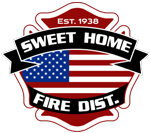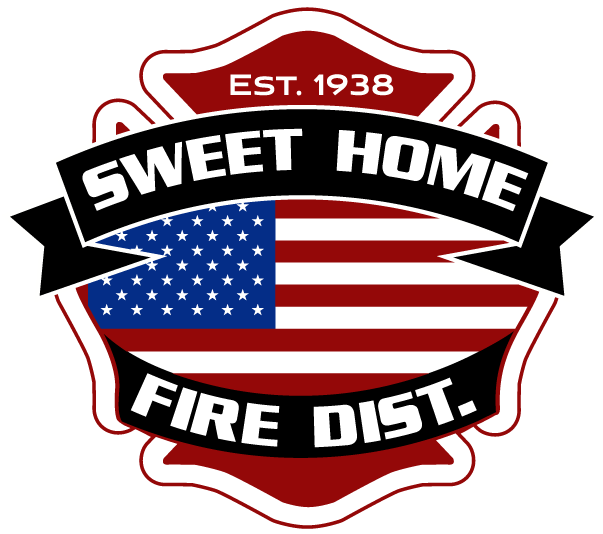WILDLAND FIRE DIVISION
Wildland Fire Division
The Wildland Division operates under the supervision of Division Chief Christian Whitfield
Community Wildfire Risk
Reduction Program
As of July 2023, Sweet Home Fire District has started a Community Wildfire Risk Reduction Program. The program is aimed to help Sweet Home and the surrounding areas prepare for and prevent wildfires.
After the devastating 2020 fires in Oregon, Sweet Home Fire is dedicated to helping avoid similar damage and destruction in our community. Sweet Home Fire District, with the help of the Oregon State Fire Marshal (OSFM), has hired a new position of Community Wildfire Risk Reduction Program Manager. This position will be working directly with the community members, City of Sweet Home, Oregon State Fire Marshal, Oregon Department of Forestry, United States Forest Service, Cascade Timber Consulting and others. This program is aimed to provide information and tools to assist the community in mitigating any risks associated with wildfires and will be growing and changing as participation increases. The overall goal of the program is to reduce or eliminate effects of wildfires in our community.
With the implementation of this program, Sweet Home Fire will be providing free on-site assessments for property owners/renters to identify risks and help mitigate them. This will include;
Willamette national forest- pcl project
The Sweet Home Fire District, in coordination the Willamette National Forest and other partners and stakeholders, are making significant progress to address the increased frequency of large fires across the landscape. In 2020, historically significant wildfires occurred on the Forest, followed by atypically large fires in 2021, 2022, 2023 and 2024. Consideration and use of Potential Operational Delineations (PODs) and Potential Containment Lines (PCLs) is central to our management and preparation for wildfire, as a prolonged drought continues to influence fire behavior, duration and dynamics in the western Cascades, resulting in widescale impacts to air quality and public and private values on the landscape. The values at risk include multiple communities, critical infrastructure such as railroads, powerlines, communication sites, and municipal water sources, natural resources such as critical habitat, short- and long-term air quality, recreation and Wilderness, as well as social and economic infrastructure related to adjacent private industrial timber lands and operations. The PCL contract is between Sweet Home Fire and the Willamette National Forest is a pilot stewardship service contract. This is for fuels treatment on 1313 acres on the Sweet Home Ranger District adjacent to several district roads.
Sweet Home Ranger District, which has substantial checkerboard ownership, has been working closely with industry partners to identify how to connect features on the landscape that will provide wildland firefighting opportunities. Project locations were selected to complement ongoing work with adjacent private industrial timberland owners to ensure fuel treatments between ownerships are in alignment to maximize opportunities to control wildfires in the area.
Industry partners have already implemented portions of the features on their lands for this effort.
These agreements will help the Forest take advantage of opportunities to work with non-typical local partners, such as the Sweet Home Fire Department, to implement PCL treatments.
The South Santiam Watershed Council has convened all parties (Federal, State, County, City, and private) to work together towards this goal, building a common map so that we can all see what work has been completed, what work is in planning stages, and where fire lines exist from previous wildfire suppression activities. This will help in project planning and timing of implementation as well as being able to quickly develop wildfire suppression strategies together in the event of a wildfire.
These agreements will allow the Forest to take advantage of the efficiencies of working with local stakeholders that share a common interest in wildfire resiliency in the local communities. The grant with NFF will set the framework for work to be accomplished through committed partners such as the Sweet Home Fire District and charts a path for local community solutions to implement fuels treatments in other communities across the forest.
Sweet Home Fire District has developed a Wildland Fire Division to address this work. Along with building PCL’s the Fire District has created a wildland fire hand crew. This partnership has led to not only a potential increase for fire reliance, in the Sweet Home area, but increases our response to a fire.
Defensible Space and Wildfire Risks
What is defensible space?
Defensible space is the buffer between your structure and the surrounding area. Adequate defensible space acts as a barrier to slow or halt the progress of fire that would otherwise engulf your property. It also helps ensure the safety of firefighters defending your home.
How can Defensible Space protect my home?
Defensible space is one of the most effective ways to prevent your home from burning during a wildfire. Embers are one of the leading causes of home loss in wildfires. Embers can travel up to 3 miles in front a fire. Defensible space directly removes the fuels that embers can ignite along with smaller fuels that can lead to the structure.
Wildfire Risk Property/Structure Assessments
The Fire District is now accepting requests to have a wildfire risk assessment performed at your house, property or business. This assessment would be with the Community Wildfire Risk Reduction Specialist and the resident or owner that requests the assessment. During the assessment, Sweet Home Fire will provide a plan for the property to reduce immediate risks along with advice to prepare the property or structures for potential fire.

